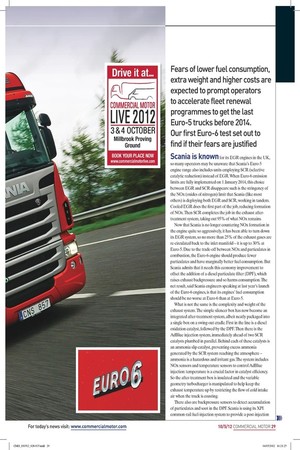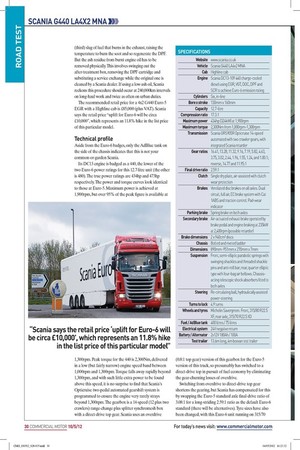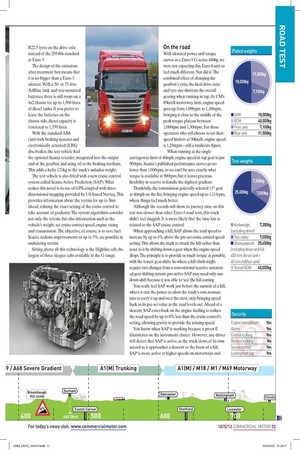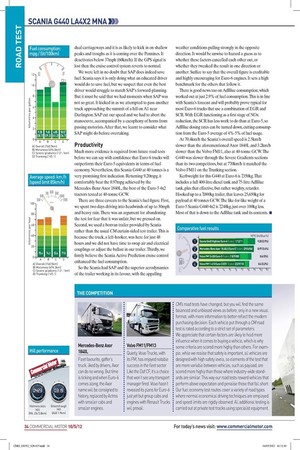The
Page 21

Page 22

Page 23

Page 26

Page 27

If you've noticed an error in this article please click here to report it so we can fix it.
ear factor
Fears of lower fuel consumption, extra weight and higher costs are expected to prompt operators to accelerate fleet renewal programmes to get the last Euro-5 trucks before 2014 Our first Euro-6 test set out to find if their fears are justified
Scania is known for its EGR engines in the UK, so many operators may be unaware that Scania’s Euro-5 engine range also includes units employing SCR (selective catalytic reduction) instead of EGR. When Euro-6 emission limits are fully implemented on 1 January 2014, this choice between EGR and SCR disappears: such is the stringency of the NOx (oxides of nitrogen) limit that Scania (like most others) is deploying both EGR and SCR, working in tandem. Cooled EGR does the first part of the job, reducing formation of NOx. Then SCR completes the job in the exhaust aftertreatment system, taking out 95% of what NOx remains.
Now that Scania is no longer countering NOx formation in the engine quite so aggressively, it has been able to turn down its EGR system, so no more than 25% of the exhaust gases are re-circulated back to the inlet manifold – it is up to 30% at Euro-5. Due to the trade-off between NOx and particulates in combustion, the Euro-6 engine should produce fewer particulates and have marginally better fuel consumption. But Scania admits that it needs this economy improvement to offset the addition of a diesel particulate filter (DPF), which raises exhaust backpressure and so harms consumption. The net result, said Scania engineers speaking at last year’s launch of the Euro-6 engines, is that its engines’ fuel consumption should be no worse at Euro-6 than at Euro-5.
What is not the same is the complexity and weight of the exhaust system. The simple silencer box has now become an integrated after-treatment system, albeit neatly packaged into a single box on a swing-out cradle. First in the line is a diesel oxidation catalyst, followed by the DPF. Then there is the AdBlue injection system, immediately ahead of two SCR catalysts plumbed in parallel. Behind each of these catalysts is an ammonia slip catalyst, preventing excess ammonia generated by the SCR system reaching the atmosphere – ammonia is a hazardous and irritant gas. The system includes NOx sensors and temperature sensors to control AdBlue injection: temperature is a crucial factor in catalyst efficiency. So the after-treatment box is insulated and the variable geometry turbocharger is manipulated to help keep the exhaust temperature up by restricting the flow of cold intake air when the truck is coasting.
There also are backpressure sensors to detect accumulation of particulates and soot in the DPF. Scania is using its XPI common-rail fuel-injection system to provide a post-injection (third) slug of fuel that burns in the exhaust, raising the temperature to burn the soot and so regenerate the DPF. But the ash residue from burnt engine oil has to be removed physically. This involves swinging out the after-treatment box, removing the DPF cartridge and substituting a service exchange while the original one is cleaned by a Scania dealer. If using a low-ash oil, Scania reckons this procedure should occur at 240,000km intervals on long-haul work and twice as often on urban duties.
The recommended retail price for a 4x2 G440 Euro-5 EGR with a Flighline cab is £85,000 (plus VAT). Scania says the retail price “uplift for Euro-6 will be circa £10,000” , which represents an 11.8% hike in the list price of this particular model.
Technical profile
Aside from the Euro-6 badges, only the AdBlue tank on the side of the chassis indicates that this is not your common-or-garden Scania.
Its DC13 engine is badged as a 440, the lower of the two Euro-6 power ratings for this 12.7-litre unit (the other is 480). The true power ratings are 434hp and 473hp respectively. The power and torque curves look identical to those at Euro-5. Maximum power is achieved at 1,900rpm, but over 95% of the peak figure is available at 1,300rpm. Peak torque for the 440 is 2,300Nm, delivered in a low (but fairly narrow) engine speed band between 1,000rpm and 1,300rpm. Torque falls away rapidly beyond 1,300rpm, and with such little extra power to be found above this speed, it is no surprise to find that Scania’s Opticruise two-pedal automated gearshift system is programmed to ensure the engine very rarely strays beyond 1,300rpm. The gearbox is a 14-speed (12 plus two crawlers) range-change plus splitter synchromesh box with a direct-drive top gear. Scania uses an overdrive (0.8:1 top gear) version of this gearbox for the Euro-5 version of this truck, so presumably has switched to a direct-drive top in pursuit of fuel economy by eliminating the gear-churning losses of overdrive.
Switching from overdrive to direct-drive top gear shortens the gearing, but Scania has compensated for this by swapping the Euro-5 standard axle final-drive ratio of 3.08:1 for a long-striding 2.59:1 ratio as the default Euro-6 standard (there will be alternatives). Tyre sizes have also been changed, with this Euro-6 unit running on 315/70 R22.5 tyres on the drive axle instead of the 295/80s standard at Euro-5.
The design of the emissions after-treatment box means that it is no bigger than a Euro-5 silencer. With a 50or 75-litre AdBlue tank and rear-mounted batteries, there is still room on a 4x2 chassis for up to 1,500 litres of diesel tanks. If you prefer to leave the batteries on the chassis side, diesel capacity is restricted to 1,370 litres.
With the standard ABS (anti-lock braking system) and electronically actuated (EBS) disc brakes, the test vehicle had the optional Scania retarder, integrated into the output end of the gearbox and using oil as the braking medium. This adds a hefty 121kg to the truck’s unladen weight.
The test vehicle is also fitted with a new cruise control system called Scania Active Prediction (SAP). What makes this novel is its use of GPS, coupled with threedimensional mapping provided by US-based Navteq. This provides information about the terrain for up to 3km ahead, refining the exact setting of the cruise control to take account of gradients. The system algorithms consider not only the terrain, but also information such as the vehicle’s weight, set cruise control speed, engine rating and transmission. The objective, of course, is to save fuel: Scania reckons improvements of up to 3% are possible in undulating terrain.
Sitting above all this technology is the Highline cab, the largest of three sleeper cabs available in the G-range.
On the road
With identical power and torque curves as a Euro-5 G-series 440hp, we were not expecting this Euro-6 unit to feel much different. Nor did it. The combined effect of changing the gearbox’s ratio, the final-drive ratio and tyre size shortens the overall gearing when running in top. At CM’s 85km/h motorway limit, engine speed goes up from 1,096rpm to 1,186rpm, bringing it close to the middle of the peak torque plateau between 1,000rpm and 1,300rpm. For those operators who still choose to set their speed limiters at 90km/h, engine speed is 1,256rpm – still a moderate figure.
When running at the singlecarriageway limit of 40mph, engine speed in top gear is just 900rpm. Scania’s published performance curves go no lower than 1,000rpm, so we can’t be sure exactly what torque is available at 900rpm, but it leaves precious flexibility in reserve to handle the slightest gradient. Thankfully, the transmission generally selected 11th gear at 40mph on the flat, bringing engine speed up to 1,114rpm, where things feel much better.
Although the records will show its journey time on this test was slower than other Euro-5 road tests, this truck didn’t feel sluggish. It is more likely that the time lost is related to the SAP cruise control.
When approaching a hill, SAP allows the road speed to increase by up to 4% above the pre-set cruise control speed setting. This allows the truck to attack the hill rather than react to it by shifting down a gear when the engine speed drops. The principle is to provide as much torque as possible, with the fewest gear-shifts. So where a hill climb might require two changes from a conventional reactive automated gear shifting system, pro-active SAP may need only one down-shift because it was able to ‘see’ the hill coming.
You really feel SAP work just before the summit of a hill, where it cuts the power to allow the truck’s own momentum to carry it up and over the crest, only bringing speed back to its pre-set value as the road levels out. Ahead of a descent, SAP eases back on the engine fuelling to reduce the road-speed by up to 8% less than the cruise-control’s setting, allowing gravity to provide the missing speed.
You know when SAP is working because a green E illuminates on the instrument cluster. However, any driver will detect that SAP is active, as the truck slows of its own accord as it approaches a descent or the brow of a hill. SAP is more active at higher speeds on motorways and dual carriageways and it is as likely to kick in on shallow peaks and troughs as it is coming over the Pennines. It deactivates below 37mph (60km/h). If the GPS signal is lost then the cruise control system reverts to normal.
We were left in no doubt that SAP does indeed save fuel. Scania says it is only doing what an educated driver would do to save fuel, but we suspect that even the best driver would struggle to match SAP’s forward-planning. But it must be said that we had moments when SAP was not so great. It kicked in as we attempted to pass another truck approaching the summit of a hill on A1 near Darlington. SAP cut our speed and we had to abort the manoeuvre, accompanied by a cacophony of horns from passing motorists. After that, we learnt to consider what SAP might do before overtaking.
Productivity
Much more evidence is required from future road tests before we can say with confidence that Euro-6 trucks will outperform their Euro-5 equivalents in terms of fuel economy. Nevertheless, this Scania G440 at 40 tonnes is a very promising first indication. Returning 9.20mpg, it comfortably beat the 8.97mpg achieved by the Mercedes-Benz Axor 1840L, the best of the Euro-5 4x2 tractors tested at 40-tonne GCW.
There are three caveats to the Scania’s fuel figure. First, we spent two days driving into headwinds of up to 30mph and heavy rain. There was an argument for abandoning the test for fear that it was unfair, but we pressed on. Second, we used a boxvan trailer provided by Scania rather than the usual CM curtain-sided test trailer. This is because the truck, a left-hooker, was here for just 48 hours and we did not have time to swap air and electrical couplings or adjust the ballast in our trailer. Thirdly, we firmly believe the Scania Active Prediction cruise control enhanced the fuel consumption.
So the Scania had SAP and the superior aerodynamics of the trailer working in its favour, with the appalling weather conditions pulling strongly in the opposite direction. It would be unwise to hazard a guess as to whether these factors cancelled each other out, or whether they tweaked the result in one direction or another. Suffice to say that the overall figure is creditable and highly encouraging for Euro-6 engines. It sets a high benchmark for the others that follow it.
There is good news too on AdBlue consumption, which worked out at just 2.9% of fuel consumption. This is in line with Scania’s forecast and will probably prove typical for most Euro-6 trucks that use a combination of EGR and SCR. With EGR functioning as a first stage of NOx reduction, the SCR has less work to do than at Euro-5, so AdBlue dosing rates can be turned down, cutting consumption from the Euro-5 average of 4%-5% of fuel usage.
At 70.4km/h the Scania’s overall speed is 2.5km/h slower than the aforementioned Axor 1840L and 3.2km/h slower than the Volvo FM11, also at 40-tonne GCW. The G440 was slower through the Severe Gradients sections than its two competitors, but at 77.0km/h it matched the Volvo FM11 on the Trunking section.
Kerbweight for this G440 at Euro-6 is 7,350kg. That includes a full 400-litre diesel tank and 75-litre AdBlue tank, plus that effective, but rather weighty, retarder. Hooked up to a 7,000kg trailer, that leaves 25,650kg for payload at 40 tonnes GCW. The like-for-like weight of a Euro-5 Scania G440 4x2 is 7,248kg, just over 100kg less. Most of that is down to the AdBlue tank and its contents. ■












































